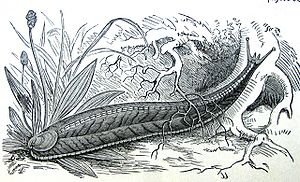Gray-yellow backpack snail
| Gray-yellow backpack snail | ||||||||||||
|---|---|---|---|---|---|---|---|---|---|---|---|---|

Gray-yellow backpack snail ( Testacella haliotidea Draparnaud, 1801) |
||||||||||||
| Systematics | ||||||||||||
|
||||||||||||
| Scientific name | ||||||||||||
| Testacella haliotidea | ||||||||||||
| Draparnaud , 1801 |
The gray-yellow backpack snail ( Testacella haliotidea ) is a predatory snail from the genus and family of backpack snails ( Testacella or Testacellidae) from the subordination of land snails (Stylommatophora). The Latin species name haliotidea alludes to the ear-shaped shape of the rudimentary shell, on the basis of which it is also counted among the "half-slugs".
features
In the adult animal, the housing is relatively small, flat, and sits on the rear part just before the end of the body. The juvenile animal can initially withdraw into the housing. Then the growth of the housing quickly lags behind the growth of the soft body. In the adult stage, the animal becomes a "half-slug". The small case measures 7 to 8 mm in length and 5 to 6 mm in width. It is usually yellowish and has coarse strips of growth on the surface that give the surface a wrinkled appearance. The animal is stretched out 8 to 12 cm long and about 1 cm wide. When at rest, the animal contracts in a hemispherical manner. The body color varies from cream yellow to light yellow to light brown, the sole of the foot is significantly lighter than the back. The two side furrows begin at the front edge of the mantle, clearly separated from each other shortly before the rudimentary housing.
Way of life, occurrence and distribution
The species is synanthropic and prefers to live in cultivated landscapes, such as gardens and parks, in the south of the distribution area also in fields and in vineyards. The species is nocturnal and lives predatory on earthworms, which are usually devoured completely. Whether the gray-yellow backpack snail also eats other snails and possibly even conspecifics is a matter of dispute in the literature. The distribution area extends from the British Isles to western France and the Mid-Atlantic Islands (Azores, Canary Islands, Madeira). The isolated occurrences near Heidelberg in southern Germany, in Schleswig-Holstein, near Turin (northern Italy) and on Jutland (Denmark) are traced back to drag-out. In the meantime, the species has not only been introduced within Europe, but also to New Zealand, Australia and North America.
Systematics
The gray-yellow backpack snail ( Testacella haliotidea Draparnaud, 1801) has numerous synonyms: Testacella barcinonensis Pollonera, 1888, Testacella dubia Pollonera, 1888, Testacella esserana Fagot, 1892, Testacella europaea Roissy, 1805, Testacella galliae Oken, 18, pasc and Massotella Testacella servaini Massot, 1870. Gray-yellow backpack snail ( Testacella haliotidea ) is the typical species of the genus Testacella Draparnaud, 1801.
Individual evidence
- ↑ cf. Discussion in Frömming, p. 73
- ↑ MollBase
- ^ AnimalBase
- ^ Commonwealth Scientific and Industrial Research Organization
- ↑ Robert Forsyt: Checklist of Terrestrial Molluscs in British Columbia PDF
literature
- Rosina Fechter and Gerhard Falkner: molluscs. 287 pp., Mosaik-Verlag, Munich 1990 (Steinbach's Nature Guide 10) ISBN 3-570-03414-3
- Michael P. Kerney, RAD Cameron & Jürgen H. Jungbluth: The land snails of Northern and Central Europe. 384 pp., Paul Parey, Hamburg & Berlin 1983, ISBN 3-490-17918-8
- Ewald Frömming: Biology of the Central European Landgastropods. 404 p., Duncker & Humblot, Berlin 1954.